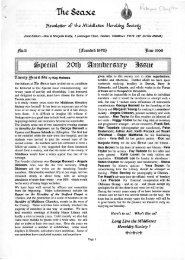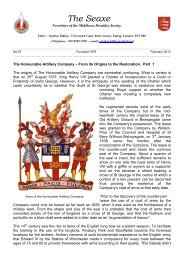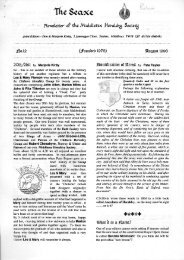No.30 - Middlesex Heraldry Society
No.30 - Middlesex Heraldry Society
No.30 - Middlesex Heraldry Society
You also want an ePaper? Increase the reach of your titles
YUMPU automatically turns print PDFs into web optimized ePapers that Google loves.
The Ducally Gorged and Chained Swan<br />
by C. J. (Sedge) Smith<br />
John Rous in The Rous Roll (my copy is the Alan<br />
Sutton version of 1980) refers in Section 18 to Eneas - a<br />
kyngs son and quenys the eldest of his breden and<br />
sustere vij born at a byrthe where the oder by<br />
enchauntment were forshapyd un to swannys with colers<br />
and chenys of gold. However, all the other versions of<br />
the Swan Knight story talk of the six brothers and one<br />
sister being born with gold chains about their necks, and it<br />
was when these were removed that the boys turned into<br />
swans - the girl escaped. One of the chains was destroyed<br />
so that when the other five were returned to five of the<br />
swans they became human once more, but the sixth<br />
remained in swan form. It was this one drew the boat<br />
containing his brother - the other four brothers seem to<br />
fade from the story at this point.<br />
It is difficult to know how or when the collared swan<br />
enters our collection of royal and noble badges. The swan<br />
that appears on the seal of Humphrey de Bohun, Earl of<br />
Hereford and Essex on the Baron's Letter to Pope<br />
Boniface in 1301 has no collar and is close - with wings<br />
down. The swans at the base of the seal of Thomas of<br />
Woodstock, husband of Eleanor de Bohun are<br />
supposedly swans of de Bohun, but they are uncollared<br />
and close. On another seal the arms appear in front of a<br />
swan rising. Eleanor's shield shows two versions of the<br />
swan. Her arms are held by an angel standing in a boat, at<br />
each end of which is a close swan collared and chained.<br />
Above and below the lozenge with the arms are two<br />
further swans close and free. On the indenture of 1st<br />
Page 4<br />
December 1387, between Thomas of Woodstock and the<br />
Abbot of Westminster his seal bears within a<br />
quatrefoil the trunk of a tree - the woostock - standing<br />
surrounded by water, on which two chained swans, the<br />
de Bohun badge, float. The History, Principles and<br />
Practice of <strong>Heraldry</strong> [p.241]. To make life still more<br />
interesting The Antiquities of Westminster Abbey<br />
[p.21] gives a description of the brass of Eleanor de<br />
Bohun : At<br />
the foot of<br />
the tomb, on<br />
the extreme<br />
verge, are<br />
seven small<br />
badges, being<br />
repetitions of<br />
the principal<br />
cognizances<br />
of the houses<br />
of Bohun<br />
and<br />
Woodstock,<br />
which were<br />
both<br />
distinguished<br />
by a swan,<br />
although<br />
borne in a<br />
different<br />
manner. The<br />
badge of<br />
Bohun,<br />
which occurs<br />
four times<br />
upon the<br />
ledge, is a<br />
swan close,<br />
and was<br />
derived from<br />
the<br />
Mandevilles -<br />
that assumed by Thomas of Woodstock was a swan<br />
argent, with wings expanded, ducally gorged and<br />
chained or; this badge is repeated three times and was<br />
most probably enamelled, over the lead which remains,<br />
the collars and chains of brass are still seen.<br />
BUT, just to add to our confusion on page 23 we find ...<br />
over the principal arch ... is a quatrefoil, charged with a<br />
swan, close, ducally gorged and chained, the peculiar<br />
badge of the Bohun family. There is also a note to the<br />
effect that Thomas gave to the Abbey of St Albans a<br />
replica of his badge, a white swan expanding its wings<br />
(but no ducal coronet or chain). A swan with expanded<br />
wings may also be seen on the brass on the sinister side<br />
where the arches begin. J. G. Nichols, in his articles on<br />
Royal Livery Collars in the Gentleman's Magazine,<br />
dismissed any idea of the brass distinguishing between the<br />
Bohun and Lancastrian swan.<br />
Others have maintained the difference. W. J. White in<br />
The Swan, the Stafford and some<br />
Buckinghamshire Yorkist Connections writes (p. 179)<br />
Following the demise of William de Mandeville at the














